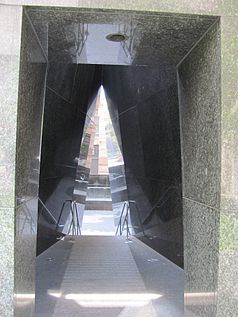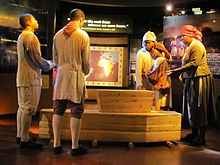African Burial Ground
| African Burial Ground National Monument | ||
|---|---|---|
| Supervision in the draft | ||
|
|
||
| Location: | New York , United States | |
| Next city: | Manhattan | |
| Surface: | 0 km² | |
| Founding: | February 27, 2006 | |
| Address: | Broadway 290 | |
| General view of the outdoor area | ||
| Excerpt from the “cosmogram” with symbols of various religions | ||
| View through the libation chamber to the east | ||
| Looking up through the libation chamber to the federal building that was erected in the cemetery | ||
The African Burial Ground [ æfrɪkən berɪəl graʊnd ] is the only under monument protection standing archaeological ground monument and a memorial in the city of New York . It has been designated a National Monument since 2006 . It is reminiscent of an African American cemetery used in the 17th and 18th centuries, where around 15,000 people were buried.
In addition to the official name African Burial Ground National Monument ( German : African burial place ), there are a number of other historic part designations: Negro Burying Place , Negros Burying Ground and African Burying Ground .
location
The African Burial Ground was until 1794 just north of the " walls " of Nieuw Amsterdam / New York, a palisade . When the city was expanded in 1745, the palisade was pulled across the cemetery and part of it was cut off. As the city continues to grow, the site of the former cemetery is now in an area bounded by Duane Street , Broadway , Chambers Street and Elk Street . The memorial is in the corner between Duane Street and Elk Street . The outdoor memorial includes a visitor center on the corner of Duane Street and Broadway , on the ground floor of the federal building where the historic cemetery was found. The visitor center can therefore only be visited after a security check. Its entrance is on Broadway .
The discovery
prehistory
In 1991, construction work on the Federal Broadway 290 office building came across a cemetery that was used for the burial of New York African Americans from 1626 to 1794 . The Afro-American population of New York at the time made up almost half of the population there, around half of them enslaved . The cemetery has been the only one open to the African American population since 1697. About 15,000 people were buried here. The burials were body burials in individual graves that were laid out in an east-west direction. The dead face west. Rites that had been brought from the African countries of origin were also followed. Coins were placed on the closed eyes, and from time to time other additions were also placed in the grave.
The cemetery was recorded in archive documents , which were obviously not used in the construction planning. So the discovery of skeletons came as a surprise to everyone. The area of the cemetery was parceled out after 1794 and sold as building land. Since the construction in this area initially managed without a cellar and was renewed several times, a massive layer of rubble formed in the cemetery, which largely protected the graves below from destruction.
The African Burial Ground was because the building authorities who wanted to eliminate her need foundation of the building after it was discovered between the African Americans of New York, interested in history and the building administration to contention, the archaeological site in circumference. The Afro-Americans saw this as a continuation of the disregard shown to them by the white majority society, demanding that the peace of the dead be respected and that the construction work should be stopped. There were public demonstrations and a 24-hour vigil. The resulting public pressure initially caused the United States Congress in 1992 to temporarily halt the construction project. The building administration then rescheduled the building project. Only part of the originally planned area was built over, but the originally planned total area of 1,400 square meters was archaeologically excavated. A memorial was erected on the remaining area.
Archaeological evidence
The excavation, which covered around 15% of the historic cemetery, revealed the remains of 419 burials. These were archaeologically documented and anthropologically examined. The dispute arose because, in the opinion of the African American, too few black archaeologists were involved in the investigations. As a result, the evaluation of the excavation results was entrusted to the African American Michael Blakey and his staff at the Cobb Institute of Howard University , Washington, DC , one of the leading institutions in African American research.
The burials come from men, women and children. The distribution of the age of death over the population buried here shows a generally similar trend compared to cemeteries of the corresponding period, where only whites were buried - especially with regard to the high child mortality rate at the time and the relatively high number of deaths among women of childbearing age. However, more African Americans died and fewer lived to old age. This reflects the poorer living conditions compared to the white population .
memorial
On April 19, 1993, the African Burial Ground was declared a National Historic Landmark (the first such archaeological site in the city of New York), that is, it was placed under the protection of historical monuments by the federal government, and on February 27, 2006 by the then President of the United States, George W. Bush , designated as a national monument .
On the one hand, the memorial was architecturally designed. This design consists of a "Kosmogramm", a round courtyard, different in its boundary walls symbols religions were carved, and built at the edge, in the plan triangular, Libationskammer , a reminder of African burial customs. This building gives the memorial an axis that is oriented in an east-west direction, analogous to the historical burials.
Secondly, at the memorial in October 2003, the remains of seven were hand-carved mahogany - coffins from Ghana buried. They were reburied in the original cemetery after extensive ceremonies and a funeral procession from Howard University, Washington, DC, via Baltimore , Wilmington , Philadelphia , Newark and Jersey City to New York. The graves can be recognized by small, otherwise unmarked mounds on the west side of the memorial.
The facility was opened to the public on October 5, 2007 and is managed by the National Park Service . He provides rangers who also give explanations about the system on site.
literature
- US Department of the Interior / National Park Service: African Burial Ground ; o. O., o. J. [leaflet, after 2003].
Web links
- National Park Service: African Burial Ground National Monument (official site; English)
- Statement by the White House (Engl.)
Individual evidence
- ↑ Listing of National Historic Landmarks by State: New York. National Park Service , accessed August 19, 2019.







